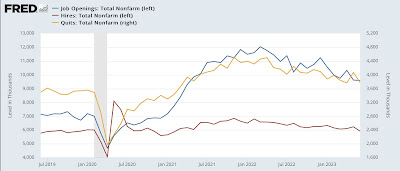June’s JOLTS report: slow progress towards a new equilibrium – by New Deal democrat Yesterday’s JOLTS report for June captured a labor market that continues to move towards a new equilibrium, mainly via a gradual decline in job openings compared with labor availability. In other words, for the umpteenth time, “deceleration.” Job openings and actual hires both declined to new 2+ year lows, and voluntary quits also declined to just above a 2+ year low: For comparison, just before the pandemic, shown at far left, all three metrics were close to or at all time highs. Hires on a monthly basis are already back to pre-pandemic levels, and voluntary quits are about 80% back to pre-pandemic levels from their post-pandemic highs. Job openings,
Topics:
NewDealdemocrat considers the following as important: Hot Topics, June Jolts report, New Deal Democrat, US EConomics
This could be interesting, too:
NewDealdemocrat writes JOLTS revisions from Yesterday’s Report
Joel Eissenberg writes No Invading Allies Act
Bill Haskell writes The North American Automobile Industry Waits for Trump and the Gov. to Act
Bill Haskell writes Families Struggle Paying for Child Care While Working
June’s JOLTS report: slow progress towards a new equilibrium
– by New Deal democrat
Yesterday’s JOLTS report for June captured a labor market that continues to move towards a new equilibrium, mainly via a gradual decline in job openings compared with labor availability. In other words, for the umpteenth time, “deceleration.”
Job openings and actual hires both declined to new 2+ year lows, and voluntary quits also declined to just above a 2+ year low:

For comparison, just before the pandemic, shown at far left, all three metrics were close to or at all time highs.
Hires on a monthly basis are already back to pre-pandemic levels, and voluntary quits are about 80% back to pre-pandemic levels from their post-pandemic highs. Job openings, which unlike hires and quits, is a “soft” rather than a “hard” metric, because it can be inflated by, e.g., permanent or sham listings, have now retreated by slightly more than 50% to their pre-pandemic levels.
By contrast, layoffs and discharges bucked the trend of softness and declined to a 6 month low (blue):

Their pre-pandemic range was about 1700-1900. Their 1527 level in June was far below that. Note that layoffs and discharges tend to lead initial jobless claims (red, right scale), which have also declined significantly in the past few weeks.
Given all the other information we have, the downturn in layoffs looks like a counter-trend move compared with the past year.
For the past 18 months, I’ve likened the job market to a game of reverse musical chairs, where there are more chairs put out by potential employers than there are job applicants willing to fill them. June’s JOLTS report continued the trend we’ve seen for the past 15 months of a jobs market slowly returning towards a convergence of the number of chairs and players. It is likely that Friday’s employment report will show more of the same as well.
May JOLTS report: continued decelerating trend, but still extremely positive, Angry Bear, New DEal democrat
